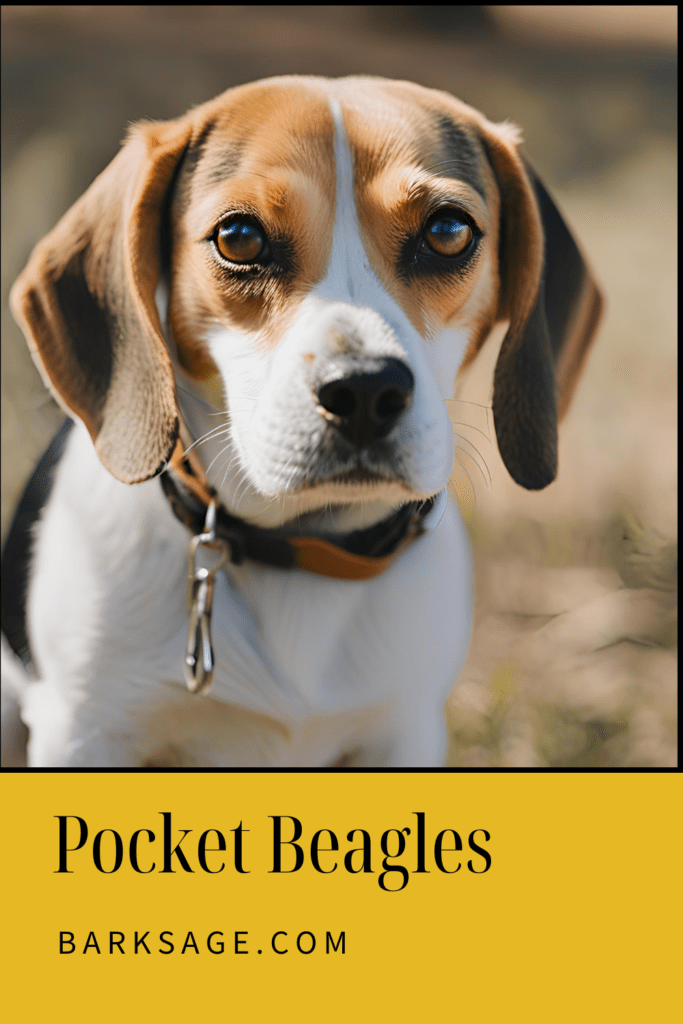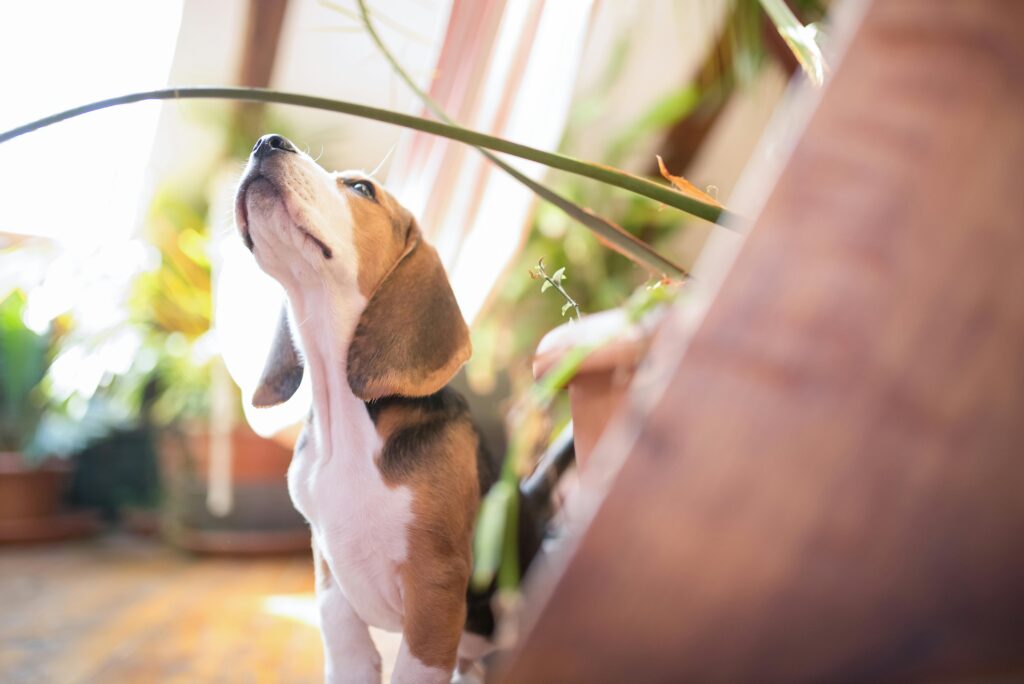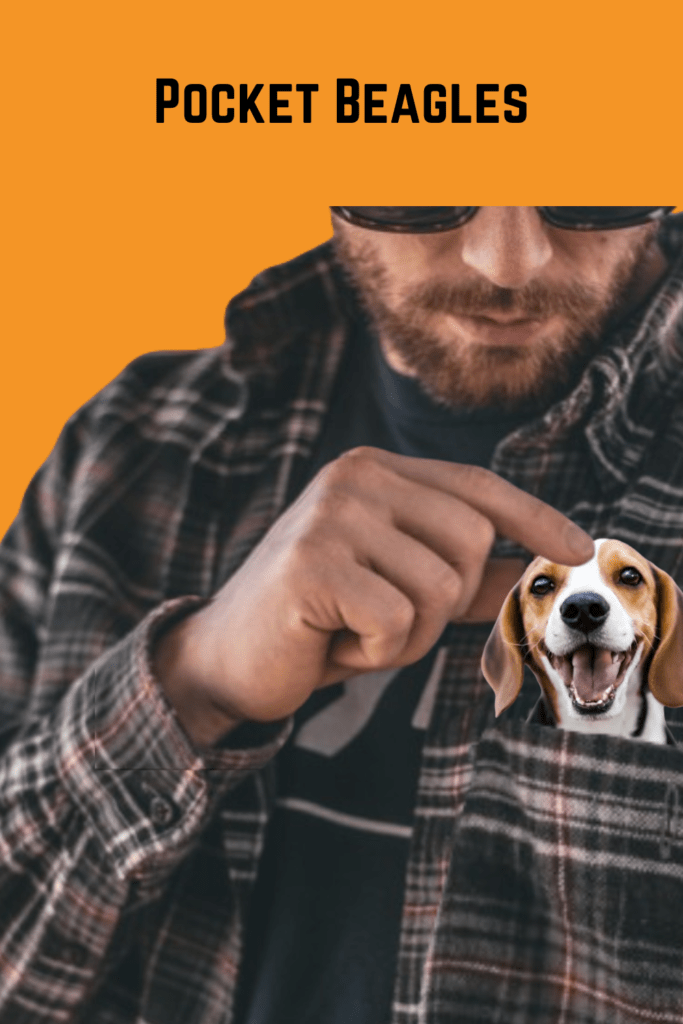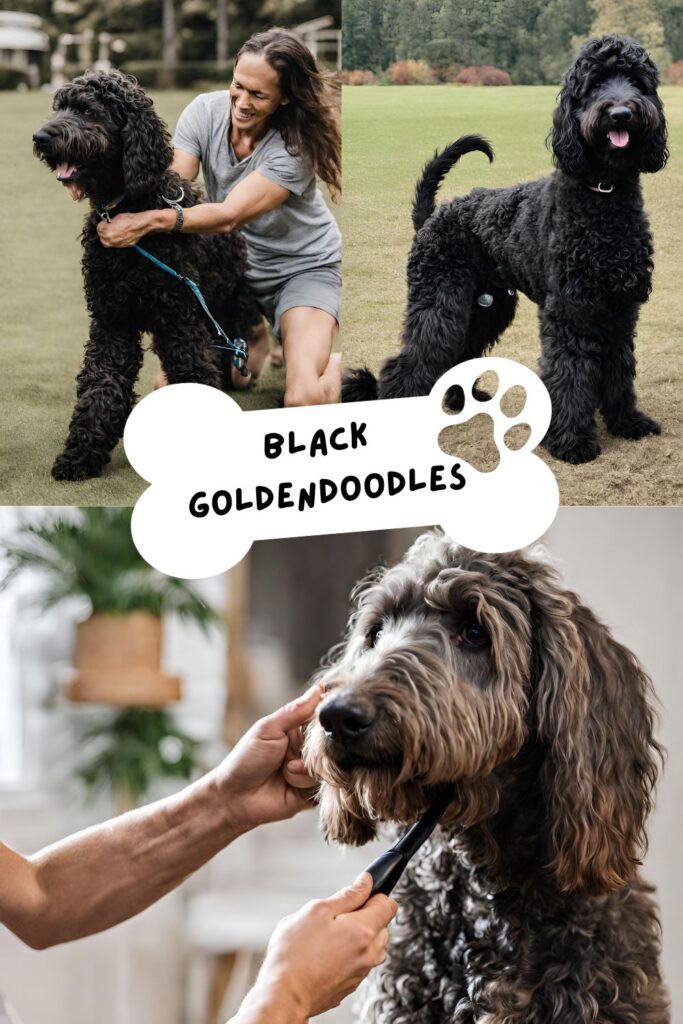
Introduction
Welcome to the enchanting world of Pocket Beagles, the miniaturized version of the beloved Beagle breed. In this comprehensive guide, we’ll explore the history, temperament, care, and unique characteristics that make Pocket Beagles a captivating choice for dog enthusiasts.
Pocket Beagle Overview
The Truth About Pocket Beagles
“Pocket Beagles” is a term often used to describe smaller-sized Beagles, but it’s crucial to note that there is no official breed recognized as a “Pocket Beagle” by major kennel clubs. The concept of miniature Beagles has led to some misconceptions, and it’s important to understand the truth behind their petite stature.
Origins and Misconceptions
The Beagle is a distinct breed with a standard size recognized by kennel clubs. Some breeders may selectively breed smaller Beagles to create dogs that fall below the standard size range. These smaller Beagles are sometimes informally referred to as “Pocket Beagles.”.
Beagles have a long history, with roots traced back to ancient Greece. The modern Beagle as we know it today was developed in England in the 19th century.
The term “Pocket Beagle” may have historical relevance, as smaller Beagles were favored by hunters who wanted compact and agile dogs to fit into their pockets or saddlebags during hunting expeditions.
The Reality
While smaller Beagles do exist, they should still conform to the breed standard in terms of temperament, health, and overall structure. True Beagles, regardless of size, should exhibit the breed’s characteristics, including a friendly demeanor, a keen sense of smell, and a sturdy build.
Beagles come in two official size varieties: 13 inches and under at the shoulder, and 13 to 15 inches at the shoulder, as recognized by the AKC.
The term “Pocket Beagle” is sometimes used to describe Beagles that are smaller than the breed standard. However, breeding for extremely small sizes can lead to health issues and is not endorsed by responsible breeders.
Fascination with Miniature Beagles
The fascination with miniature Beagles may stem from the desire for a more compact and manageable-sized dog, especially in urban living environments. However, potential owners must prioritize responsible breeding practices and the well-being of the dogs over size preferences.
Some people mistakenly use the term “Pocket Beagle” to describe miniature or teacup versions of Beagles. It’s important to note that responsible breeding practices focus on maintaining the health and well-being of the dog rather than achieving extremely small sizes.
Selective Breeding and Health
Breeders who prioritize creating smaller Beagles should do so through ethical and responsible breeding practices, ensuring the health and welfare of the dogs. Unethical breeding solely for size reduction can lead to health issues and compromise the breed’s overall well-being.
In summary, while smaller Beagles may be endearingly referred to as “Pocket Beagles,” it’s essential for prospective owners to seek reputable breeders who prioritize health, temperament, and adherence to the breed standard, regardless of size. Responsible breeding practices contribute to the creation of healthy and well-adjusted Beagles, avoiding potential pitfalls associated with size-focused breeding trends.
why are Miniature Beagles so popular?
Uncover the reasons behind the popularity of miniature Beagles and how they captured the hearts of dog lovers. Examine the demand for smaller-sized Beagles and the implications of breeding for size.
The concept of miniature Beagles, sometimes referred to as “Pocket Beagles,” has gained popularity for various reasons, capturing the hearts of dog lovers. Several factors contribute to the fascination with smaller-sized Beagles:
- Manageable Size:
- Smaller Beagles are often perceived as more manageable, especially for individuals living in smaller spaces such as apartments or homes with limited outdoor areas. Their compact size may appeal to those seeking a dog that fits well into various living environments.
- Urban Living:
- In urban and suburban settings, the demand for smaller-sized dogs has increased. Smaller Beagles may be seen as a suitable option for individuals and families looking for a dog companion that is well-suited to city living.
- Adaptability:
- Smaller Beagles may be more adaptable to certain lifestyles, including those of seniors or individuals with physical limitations. Their size can make them easier to handle for individuals who may struggle with larger, more robust breeds.
- Cuteness Factor:
- The appeal of small dogs, often associated with a high cuteness factor, contributes to the demand for miniature Beagles. Their petite stature and charming expressions make them endearing to dog lovers.
- Social Media and Trends:
- The influence of social media platforms and dog-related trends can contribute to the popularity of specific breeds or size variations. Images and videos of adorable miniature Beagles shared online can generate interest and contribute to the demand for these dogs.
Implications of Breeding for Size:
While the desire for smaller-sized Beagles is understandable, it’s essential to consider the potential implications of breeding for size. Unethical breeding practices solely focused on size reduction can lead to health issues and compromise the overall well-being of the dogs. Responsible breeders prioritize adherence to the breed standard, ensuring that size considerations do not compromise essential traits such as temperament, health, and structural soundness.
Prospective owners interested in smaller Beagles should seek reputable breeders who prioritize responsible breeding practices and the welfare of the dogs. Size considerations should be secondary to the health and overall quality of the breed. It’s important to avoid supporting breeders who prioritize size over the well-being of the animals, as this can contribute to potential health problems in the long run.
Does this Mean There Are Tiny Beagles?
Explore the distinctions between Pocket Beagles and “tiny” Beagles, shedding light on the nuances of size within the Beagle breed.
It’s important to clarify that the term “Pocket Beagles” is not officially recognized by major kennel clubs, and there is no distinct breed category for them. When people refer to “Pocket Beagles,” they are typically describing smaller-sized Beagles that fall below the standard size range. The size of Beagles can indeed vary within the breed, and there may be smaller individuals that are naturally petite without specific breeding efforts to achieve a miniature size.
However, the distinction between “Pocket Beagles” and “tiny” Beagles is not well-defined in the context of recognized breed standards. The Beagle breed has a standard size range set by kennel clubs, and responsible breeding practices prioritize maintaining the health, temperament, and overall conformation of the breed, regardless of size.
If someone refers to “tiny” Beagles, it’s crucial to clarify whether they are describing Beagles that naturally fall on the smaller end of the standard size range or if they are using the term in a more informal way to describe selectively bred miniature versions.
In summary, while there may be smaller Beagles that naturally exist within the standard size range, caution is needed when discussing terms like “Pocket Beagles” or “tiny” Beagles, as these terms are not formally recognized and can sometimes be associated with breeding practices that prioritize size over the breed’s overall well-being. Responsible breeding practices should prioritize health, temperament, and adherence to breed standards rather than focusing solely on achieving a specific size.
Understand the factors influencing the size of Pocket Beagles, from genetics to selective breeding practices. Gain insights into the responsible breeding practices to ensure the health and well-being of these miniature wonders.
Pocket Beagle Pictures
Pocket Beagle Size
Pocket Beagle Personality
Pocket Beagle Breed Characteristics
The term “Pocket Beagle” is often used informally to describe smaller-sized Beagles, but it’s essential to note that there is no officially recognized breed or standard for Pocket Beagles. Characteristics associated with dogs informally referred to as Pocket Beagles may vary, but they should ideally align with the general traits of the Beagle breed. Here are some characteristics often associated with smaller Beagles:
- Size:
- Smaller than the average Beagle, potentially falling below the standard size range set by kennel clubs.
- Height may be around 10 to 13 inches at the shoulder, and weight may vary but is typically lighter than standard Beagles.
- Temperament:
- Friendly, sociable, and outgoing.
- Intelligent and curious, with a keen sense of smell.
- Playful and energetic, enjoying both outdoor activities and indoor play.
- Coat:
- Short, dense, and weather-resistant coat.
- Tricolor (black, white, and tan) is a common coat color pattern, but variations exist. To Find out more about Beagle coat colors check this out: What are the Different Beagle Colors?: A Comprehensive Guide
- Ears:
- Long, droopy ears that contribute to the Beagle’s endearing appearance.
- Ears may be slightly shorter in proportion to their smaller size.
- Eyes:
- Typically large, expressive eyes that convey a friendly and alert expression.
- Tail:
- Straight, moderately high-set tail.
- Activity Level:
- Moderate to high energy levels, requiring regular exercise to prevent boredom and ensure overall well-being.
- Adaptability:
- Adaptable to various living environments, including apartments, as long as they receive adequate exercise and mental stimulation.
It’s important to emphasize that responsible breeding practices should prioritize health, temperament, and adherence to breed standards rather than focusing solely on achieving a specific size. When considering a Beagle, regardless of size, potential owners should seek reputable breeders who prioritize the well-being of the dogs and adhere to ethical breeding practices.
Pocket Beagle Temperament And Behavior
The temperament and behavior of Beagles, including those informally referred to as “Pocket Beagles,” are generally characterized by specific traits that define the breed. Here are common temperament and behavior characteristics associated with Beagles:
- Friendly and Sociable:
- Beagles are known for their friendly and sociable nature. They typically get along well with family members, including children, and can be amiable with strangers and other pets.
- Curious and Inquisitive:
- Beagles have a keen sense of smell, and their curious nature often leads them to explore their surroundings. They may follow scents and investigate interesting smells.
- Intelligent:
- Beagles are intelligent dogs that respond well to training. They have a quick learning ability and are known for their problem-solving skills.
- Playful and Energetic:
- Beagles are playful and energetic, enjoying playtime and various activities. Regular exercise is important to keep them physically and mentally stimulated.
- Pack Animals:
- Beagles are pack animals and thrive in the company of their human family. They may develop strong bonds with their owners and may experience separation anxiety if left alone for extended periods.
- Vocal:
- Beagles are known for their distinct howl or bay, which is a part of their hunting heritage. They may vocalize when excited, bored, or trying to alert their owners.
- Food Motivated:
- Beagles often have a strong food drive and may be motivated by treats during training sessions. This can be beneficial for positive reinforcement training.
- Digging Instinct:
- Beagles may have an instinct to dig, a behavior rooted in their hunting background. Providing designated areas for digging can help manage this behavior.
- Adaptable:
- Beagles are generally adaptable to various living environments. They can do well in both urban and suburban settings, provided they receive sufficient exercise and mental stimulation.
It’s important to note that individual dogs, even within the same breed, can vary in temperament based on factors such as genetics, socialization, and training. Responsible ownership, positive reinforcement training, and providing proper care and stimulation contribute to a well-behaved and happy Beagle, whether they are informally referred to as “Pocket Beagles” or fall within the standard size range.
Pocket Beagle Coat type
Pocket Beagle Coat Color
Pocket Beagle Care & Grooming
Caring for a Beagle, whether it’s informally referred to as a “Pocket Beagle” or falls within the standard size range, involves attention to various aspects of their health, grooming, and overall well-being. Here are essential care considerations for Beagles:
- Regular Veterinary Check-ups:
- Schedule regular veterinary check-ups to monitor your Beagle’s health. Stay up-to-date on vaccinations, parasite prevention, and dental care.
- Balanced Diet:
- Provide a balanced and nutritious diet suitable for your Beagle’s size, age, and activity level. Beagles can have a tendency to gain weight, so portion control and regular exercise are crucial.
- Exercise and Mental Stimulation:
- Beagles are active and intelligent dogs that require regular exercise and mental stimulation. Daily walks, playtime, and interactive toys can help prevent boredom and keep them physically fit.
- Grooming:
- Beagles have a short, dense coat that requires regular grooming. Brush your Beagle’s coat to minimize shedding and promote a healthy skin and coat. Check ears regularly for signs of infection, and trim nails as needed.
- Training and Socialization:
- Beagles respond well to positive reinforcement training. Start early with basic obedience training and socialization to ensure a well-behaved and well-adjusted dog.
- Preventive Healthcare:
- Use preventive measures to protect your Beagle from common health issues. This includes regular flea and tick prevention, heartworm prevention, and maintaining a clean living environment.
- Provide Chew Toys:
- Beagles have a natural tendency to chew. Offer appropriate chew toys to satisfy this instinct and prevent destructive chewing behavior.
- Monitor Weight:
- Beagles can be prone to weight gain, which can impact their overall health. Monitor your Beagle’s weight and adjust their diet and exercise accordingly.
- Secure Fencing:
- Beagles have a strong sense of smell and may be prone to wandering. Ensure your yard has secure fencing to prevent them from following scents and getting lost.
- Regular Playtime:
- Beagles thrive on playtime and interaction with their owners. Set aside dedicated time for play, whether it’s fetch, puzzle toys, or other engaging activities.
- Attention and Affection:
- Beagles are social dogs that enjoy the company of their human family. Provide attention, affection, and companionship to ensure their emotional well-being.
Remember that the term “Pocket Beagle” is not an officially recognized category, and responsible breeding practices should prioritize the health and well-being of the dog rather than focusing solely on achieving a specific size. By meeting your Beagle’s physical and emotional needs, you contribute to a happy and healthy companion.
Pocket Beagles Health And Well-Being
What Health Problems Do Pocket Beagles Have?
Examine common health issues associated with Pocket Beagles, offering insights into preventive care and regular veterinary check-ups.
Pocket Beagles, like other dog breeds, may be susceptible to certain health issues. Obesity is a common concern due to their tendency to overeat, and preventive measures, such as a balanced diet and regular exercise, are essential. Their long, floppy ears make them prone to ear infections, necessitating regular cleaning. Genetic conditions, including hip dysplasia and intervertebral disc disease, can affect their skeletal and spinal health. Beagles may also experience cherry eye, hypothyroidism, epilepsy, and allergies. Selecting a reputable breeder who conducts health screenings can mitigate the risk of hereditary conditions. Routine veterinary check-ups, proper nutrition, and prompt attention to any health issues contribute to the overall well-being of Pocket Beagles.
How Long Do Pocket Beagles Live?
Explore the life expectancy of Pocket Beagles, considering factors that influence their overall lifespan.
The lifespan of a Pocket Beagle, like that of any dog, can vary based on factors such as genetics, overall health, diet, and living conditions. On average, Pocket Beagles, which are a smaller version of the standard Beagle, can live between 10 to 15 years. Providing proper veterinary care, a balanced diet, regular exercise, and a loving home environment can contribute to their overall well-being and potentially extend their lifespan. It’s important for pet owners to be attentive to their dog’s health, address any potential health issues promptly, and ensure they receive regular veterinary check-ups to maximize their chances of living a long and healthy life.
FAQ
Are Pocket Beagles Expensive?
Discuss the cost considerations associated with Pocket Beagles, including initial expenses, ongoing care, and potential veterinary costs.
The cost of Pocket Beagles can vary based on factors such as lineage, breeder reputation, and location. Generally, Pocket Beagles are considered a relatively affordable breed compared to some others, but prices can still range from a few hundred to over a thousand dollars. It’s crucial to be cautious when choosing a breeder and prioritize responsible breeding practices to ensure the health and well-being of the dog. To find out more about bagl prices, check our blog post:
How to Find a Pocket Beagle Breeder
Guide readers on finding reputable breeders who prioritize the health and well-being of Pocket Beagles. Emphasize the importance of responsible breeding practices.
When searching for a reputable Pocket Beagle breeder, it’s essential to conduct thorough research and gather recommendations from trusted sources, such as veterinarians, pet owners, and breed clubs. Explore online platforms and attend dog shows to connect with responsible breeders who adhere to ethical practices. Ask detailed questions about breeding methods, health testing, and socialization practices. A visit to the breeder’s facility provides firsthand insight into the living conditions and overall well-being of the dogs. Ensure health certifications and request references from previous buyers to gauge the breeder’s reputation. Watch out for red flags, such as unwillingness to provide information or inadequate living conditions. For more guidance on selecting a responsible breeder, check out our informative guide [insert link].
Can You Adopt a Pocket Beagle?
Explore the possibility of adopting a Pocket Beagle, providing information on rescue organizations and adoption processes.
Yes, it is possible to adopt a Pocket Beagle through various channels. While Pocket Beagles are not as common in rescue organizations as standard-sized Beagles, it’s still worth checking local animal shelters, breed-specific rescues, or online platforms dedicated to pet adoption. Additionally, some breeders may have adult or retired breeding dogs available for adoption. Adopting a Pocket Beagle can be a rewarding experience, providing a loving home to a dog in need. Be sure to inquire about the dog’s background, health history, and temperament when considering adoption, and ensure that the adoption process is facilitated through reputable sources committed to the well-being of the animals.
Are Pocket Beagles Purebred?
Clarify the concept of purebred Pocket Beagles, addressing common misconceptions and ensuring readers understand the breed standards.

Conclusion
Wrap up the comprehensive guide to Pocket Beagles, emphasizing their unique qualities, care requirements, and the joy they bring as beloved companions. Invite readers to share their experiences, ask questions, and contribute to the community of Pocket Beagle enthusiasts. Foster a sense of appreciation for these diminutive yet delightful canine companions.



